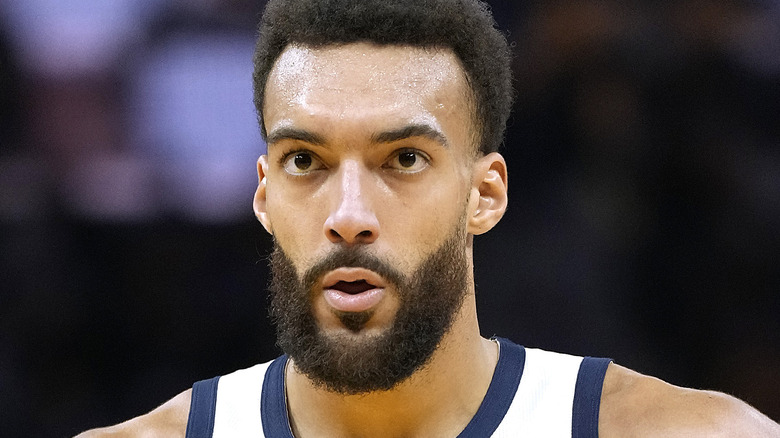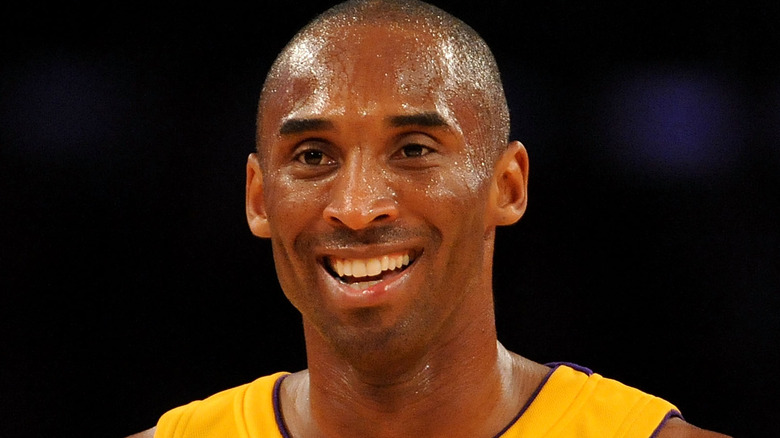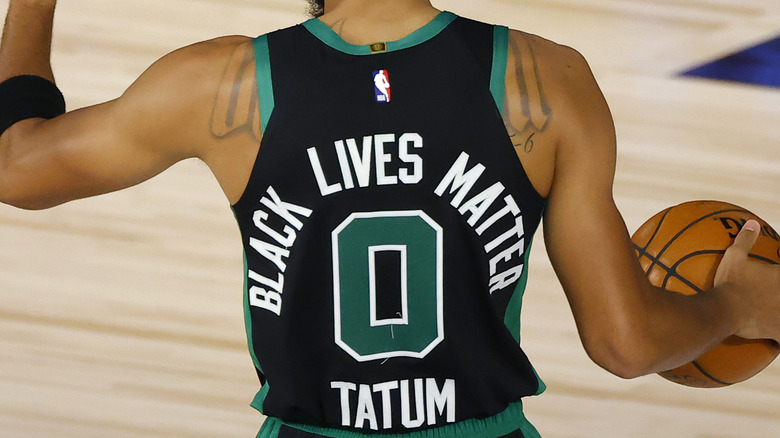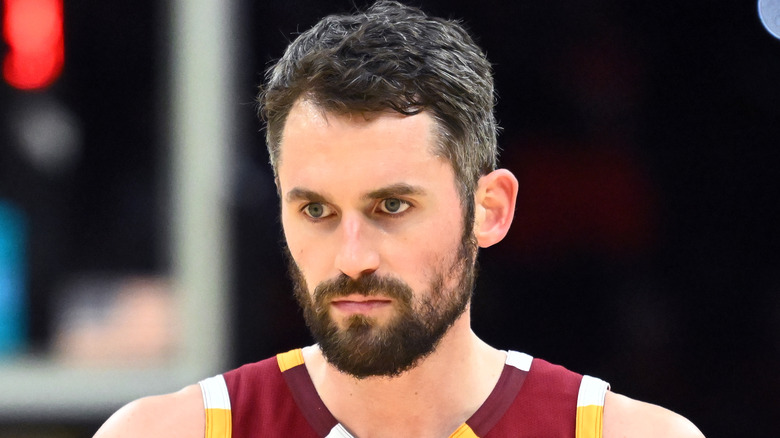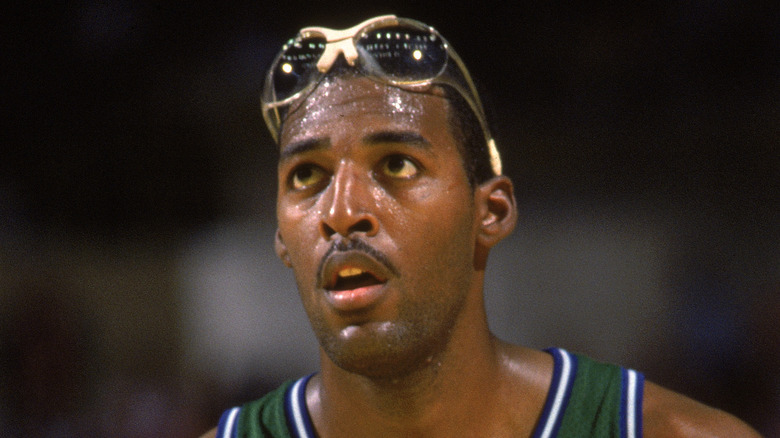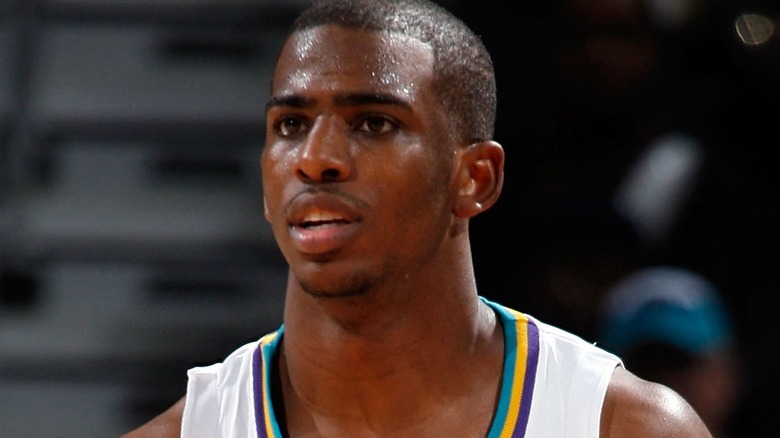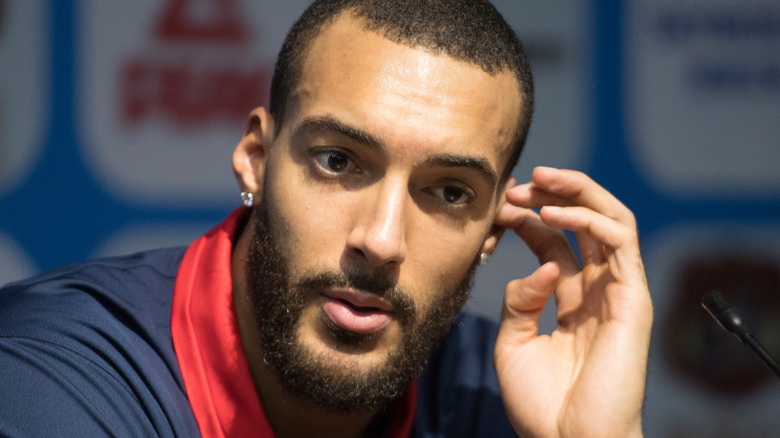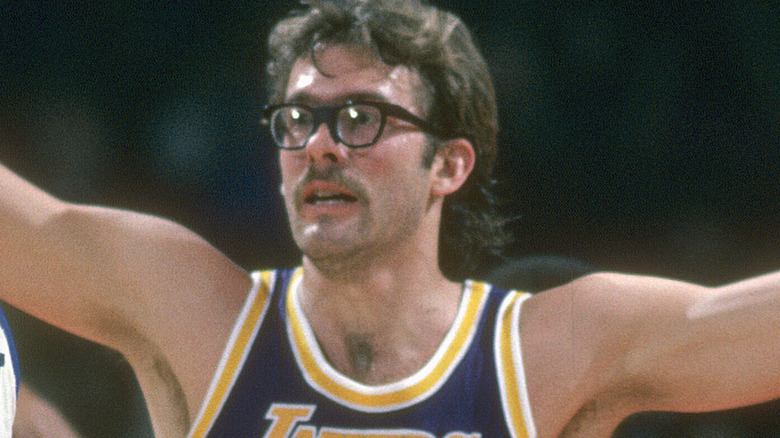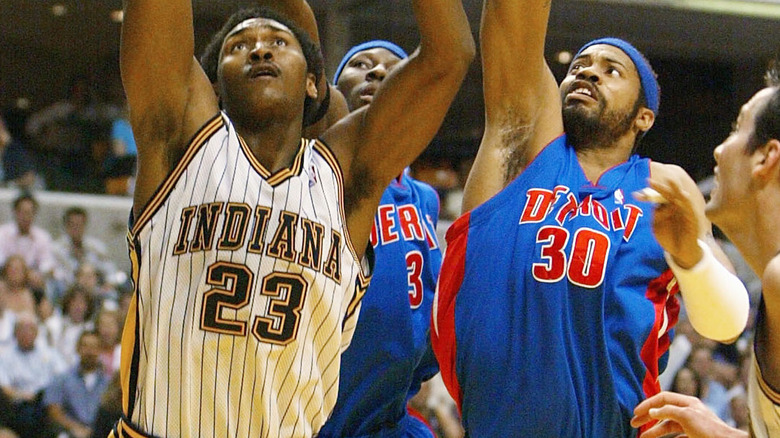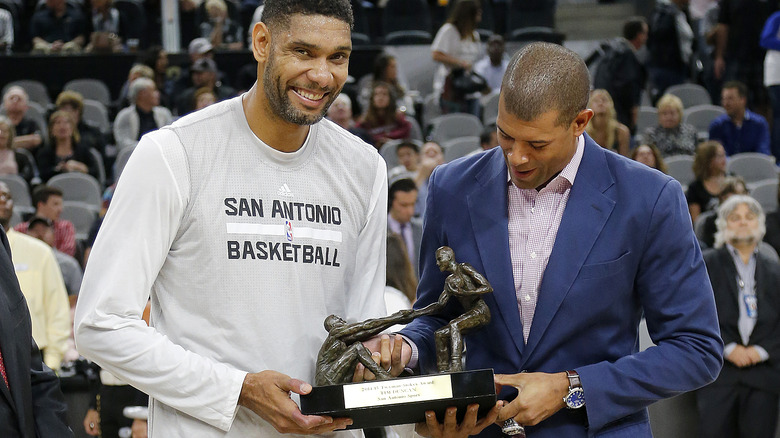Tragedies And Controversies That Changed The NBA Forever
Invented toward the end of the 19th century by James Naismith, basketball is one of the newer major sports, and its dominant professional league, the U.S.-geared National Basketball Association, one of the newer organizations. In the 2021-2022 season, the NBA celebrated its 75th birthday, growing from an obscure collection of a handful of teams into a coast-to-coast, bi-national sports juggernaut of 30 teams with players from all over the world adored and celebrated by countless millions.
The NBA has changed a lot. With so many people involved over such a long time, and with billions of dollars on the line, it's in the league's best interest to change with the times and entertain its adherents while also striving to be a place for premiere athletic prowess and competition. The league hasn't been shy about changing its rules, or letting evolution take place. Several times over its seven-plus decades of life, the NBA has had to respond quickly and seriously to catastrophic events, scandals, and heartbreaking tragedies. Here are some times when one event irrevocably changed the NBA forever.
The death of Kobe Bryant shocked the NBA into reformatting the All-Star Game
Over a 20-year career, all of it with the Los Angeles Lakers, Kobe Bryant won championships, made All-NBA, All-Defensive, and All-Star teams more than a dozen times each, was named the league MVP, and earned a spot on the NBA's 75th Anniversary Team. He retired in 2016, and then, just four years later at the age of 41, Bryant died in a helicopter crash outside Los Angeles, along with his basketball phenom daughter, Gianna, her teammates, their relatives, and the pilot, according to ESPN.
In the slate of NBA games played later that day, teams honored Bryant, who wore the #24, by taking turns taking 24-second shot-clock violations, per ESPN. According to CBS News, more than 3 million people signed a petition urging the NBA to adopt a new logo based on Bryant's image. Instead, the league changed up the format of the annual All-Star Game, an event in which Bryant participated 15 times, in the player's honor. Alluding to Bryant's notoriously hyper-competitive nature, each quarter of the game plays like a 12-minute mini game, and whichever team scores the most points earns money for a charity of choice, according to CNN. At the end of three quarters, total points are added up for a running score. The fourth quarter doesn't use a time clock — the winner is whoever gets to a target score first, which is the leading team's points total plus Bryant's 24.
The BLM movement led to the NBA adopting social justice messaging
After the spread of the coronavirus meant that the shortened and interrupted 2019-2020 season would be played in a locked-down "bubble" on the Disney World campus, many NBA players voiced the idea to the league and their union that playing basketball felt like a distraction. Following the police-caused deaths of Black Americans George Floyd and Breonna Taylor, anti-police-brutality and pro-Black Lives Matter rallies and protests sprung up in hundreds of U.S. cities. Several NBA players participated in those events, and they felt like it would be important to continue the fight for justice, civil rights, and human rights rather than head to Florida to play ball, according to The Undefeated.
The NBA and the players reached an agreement — the league would allow and encourage the messaging of the BLM movement. According to ESPN, players could opt to carry a social justice message on the backs of their jerseys, with choices including "Black Lives Matter," "Equality," "Vote," "Power to the People," "See Us," "Group Economics," and "Anti-Racist."
Black men comprise more than 70% of the NBA's player base, according to Statista, and in August 2020 (per Reuters) the NBA pledged to spend $300 million to elevate Black Americans, with an eye toward economic and educational advancement. The league created the NBA Foundation with that money, which NBA Players Association president Chris Paul called "an important step in developing opportunities for the Black community."
Kevin Love's panic attack led to the NBA paying attention to players' mental health
In November 2017, Cleveland Cavaliers star power forward and center Kevin Love experienced a panic attack for what he believed to be the first time in his life, in the middle of a game against the Atlanta Hawks. "It was like my body was trying to say to me, 'You're about to die.' I ended up on the floor in the training room, lying on my back, trying to get enough air to breathe," Love wrote on The Players' Tribune. He was rushed to a hospital, and doctors discharged him with a clean bill of health, but Love remained terrified that news of his panic attack would get out. "Call it stigma or call it fear of insecurity," Love said. "I didn't want people to perceive me as somehow less reliable as a teammate." Love then spoke openly and publicly about his experiences with depression and anxiety, as did other players, notably Toronto Raptors star DeMar DeRozan and retired Boston Celtics guard Keyon Dooling, according to CNBC.
In 2018, the National Basketball Players Association, the athletes' union, created a mental wellness program designed by a psychologist and assisted by Dooling. And just before the start of the 2019-2020 season, the NBA itself drafted rules requiring all teams to include a mental professional on their staffs.
Roy Tarpley's issues opened a conversation about substance abuse
Drafted in 1986, Roy Tarpley (via ABC News) would win the Sixth Man of the Year Award and lead the Dallas Mavericks to the Western Conference Finals. He also struggled with dependencies on cocaine and alcohol. In 1987, he entered the NBA's chemical abuse treatment program, the first strike in the league's three-strikes-and-suspension system, per the AP. Strike two came when he again sought help in January 1989. That same yeaa, Tarpley was arrested for driving while intoxicated and was suspended, then a few months later for skipping aftercare, and in March 1991, he was charged with another DWI. Later in 1991, Tarpley refused to take a drug test and was banned from the league, only to be reinstated in 1994. A year later, after another substance violation, Tarpley was again banned from the NBA.
In 2007, per the AP (via ESPN), Tarpley sued the NBA for reinstatement, arguing that his ban violated the Americans with Disabilities Act, as addiction constitutes a disability. According to the AP (via the Houston Chronicle), mediators at the Equal Employment Opportunity Commission ruled that Tarpley had a legitimate case, and the suit went forward. Tarpley said that at age 42, he was too old to actually play again, but that he wanted to set a precedent for the NBA, particularly how it approached substance abuse. "Right now it's about me getting my name back and being able to help someone else who's struggling with issues," he said.
The case was settled in 2009; Tarpley died at age 50 in 2015.
Chris Paul's head injury lead to a concussion protocol
Basketball is a very physical, potentially seriously injurious game. In the first half of the 2010-2011 season, according to the AP (via ESPN), the NBA experienced a slew of frightening and serious head injuries caused by particularly aggressive play. A total of eight players sat out games because of diagnosed concussions — a violent, brain-jostling, blow to the head (via the CDC), or experiencing the symptoms of a concussion, which may include confusion, dizziness, loss of memory or consciousness, ringing in the ears, and headaches. Among the players who suffered head injuries on the court: Mike Miller, Gary Neal, Vince Carter, Anthony Morrow, Ersan Illyasova, Damion James, and Chris Paul. The star New Orleans Hornets guard dived for a ball, and his forehead knocked into the shoulder of the Cleveland Cavaliers' Ramon Sessions. Paul's injury was so severe that he had to be removed from the court on a stretcher.
Following the Paul incident, the NBA announced that although its Team Physicians Society had been researching concussion management for a few years, it was actively working with a neurologist on developing league-wide standards for concussion management. By the end of 2011, according to the league, a concussion protocol was in place, "designed to safeguard the neurological health of NBA players." The association appointed a neurologist as Director of the NBA Concussion Program and set up training and education programs and an after-injury assessment guide, among other measures.
After Rudy Gobert got sick, the NBA shut down for months
As the COVID-19 virus spread around the world in March 2020, the NBA, according to the AP (via Sports Illustrated) moved to ban reporters from its teams locker rooms as a safety measure. Instead, players submitted to press conferences, and according to CBS Sports, Utah Jazz all-star center Rudy Gobert did just that on March 9, 2020. Jokingly dismissing virus fears and social distancing measures, according to Yahoo! Sports, Gobert purposefully touched every reporter's microphone laid out on a table.
Two days later, according to HuffPost, Gobert tested positive for the coronavirus. The news came in minutes before the scheduled start of a Jazz road game against the Oklahoma City Thunder. With a packed arena and players on the court awaiting tipoff, the NBA cancelled the game and ordered fans to leave the arena. The reporters that Gobert endangered were all tested for coronavirus, as were Gobert's Jazz teammates, with star guard Donovan Mitchell getting a positive result, per ESPN.
Mere hours after suspending Gobert's game, the NBA called off the entire season, postponing it indefinitely to prevent more players from catching the potentially deadly virus. For months, the NBA season was in limbo, until the league came up with a novel decision: a "bubble" system, where the league's best teams would finish out the season and contest the playoffs, playing and living in lockdown at Disney World in Orlando, Florida, per the Sporting News.
Kurt Rambis got clotheslined, and the NBA got serious about flagrant fouls
The rivalry between the Boston Celtics and the Los Angeles Lakers is one of the oldest and most intense in all of sports. Those teams met in the NBA Finals for the seventh time in 1984, and during the fourth game of the seven-game series, the Celtics' Kevin McHale committed one of the roughest and most memorable fouls in basketball history, probably making the heated Celtics vs. Lakers vibe all the worse for years to come. According to the New York Times, McHale stopped the Lakers' Kurt Rambis from driving to the hoop with the ball by abruptly sticking out his arm and wrapping it around his opponent, throttling him, jerking him, and sending him violently to the ground. In other words, McHale "clotheslined" Rambis. Referees called McHale on the foul, the game went on, and nobody was ejected or suspended.
That shocking moment, along with the increasingly physical style of the NBA in the late 1980s, notably that of the "Bad Boys" of the back-to-back title-winning Detroit Pistons and their pushy-shovey "bully-ball," meant the NBA needed to take action before anyone else got seriously hurt. Prior to the 1990-1991 season, the NBA made "flagrant fouls" carry stiffer punishment. On particularly violent acts, like kicking, punching, or clotheslining, the offending player might find themselves ejected, while the fouled team got free throws and then possession of the ball.
The 'Malice in the Palace' unnerved the NBA
On November 19, 2004, the Indiana Pacers arrived at The Palace of Auburn Hills for a game against the hometown Detroit Pistons. According to IndyStar, in the waning moments of the fourth quarter, Pacers star Ron Artest committed a hard foul on the Pistons' Ben Wallace, who responded with a shove, which led to a bench-clearing brawl involving members of both teams. Artest broke away from the fight and lay down on the scorer's table, whereupon a cup of liquid, launched from somewhere in the stands, nailed him. That sent Artest, and some teammates, into the seats to confront whoever he thought threw the cup. The melee had effectively moved from players fighting players on the court into the stands, where players and fans punched wildly at one another.
According to USA Today, nine players were suspended for a grand total of 146 games. Artest was most severely reprimanded, forced to sit out the rest of the new 2004-2005 season. Pacers management adopted a number of new policies with the aim of preventing history repeating, including a plan to stop selling alcoholic beverages late in games, boosting arena and team security, and creating a code of conduct for spectators. The roster changed, too. Within two years, 80% of the players present for the "Malice in the Palace" were no longer Pacers, including Ron Artest, who, desperate and eager for a new start, changed his name to Metta World Peace (via The Hollywood Reporter).
The inspiration behind the Twyman-Stokes Award
Maurice Stokes entered the NBA in 1955-'56, and the Rookie of the Year was also named to the All-Star team three times, overlapping with appearances by his Rochester (later Cincinnati) Royals teammate, Jack Twyman.
Twyman's career would last more than a decade, while Stokes' would end immediately after suffering a horrific on-court injury. During a 1958 game with the Minneapolis Lakers, per ESPN, Stokes took a fall and landed on his head. He briefly lost consciousness, but without much in the way of medical protocols at the time, he got up and continued to play. Within the week, he'd suffer several seizures and be paralyzed for life. The Royals immediately dropped Stokes from its payroll, and the NBA didn't offer a pension or medical assistance, leaving Stokes on the hook for hundreds of thousands of dollars in medical bills. So, Twyman stepped in to save his teammate, becoming his legal guardian, directing multiple fundraising events, and suing to get workman's compensation benefits for Stokes.
In honor of that deep bond and profound compassion, the NBA created an award to recognize high levels of character in active players. Since the 2012-2013 season, the NBA honors the recipient of the Twyman-Stokes Teammate of the Year Award. According to the NBA, the prize goes to "the best teammate" who demonstrates leadership and mentorship skills both on and off the court. Past winners include Tim Duncan, Dirk Nowitzki, Mike Conley, and Damian Lillard.
